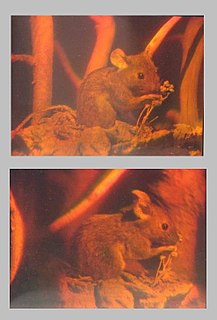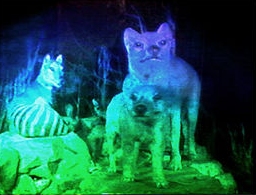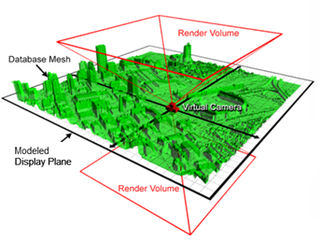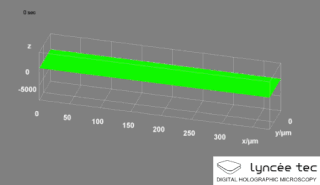
The holographic principle is a principle of string theories and a supposed property of quantum gravity that states that the description of a volume of space can be thought of as encoded on a lower-dimensional boundary to the region—preferably a light-like boundary like a gravitational horizon. First proposed by Gerard 't Hooft, it was given a precise string-theory interpretation by Leonard Susskind who combined his ideas with previous ones of 't Hooft and Charles Thorn. As pointed out by Raphael Bousso, Thorn observed in 1978 that string theory admits a lower-dimensional description in which gravity emerges from it in what would now be called a holographic way. The prime example of holography is the AdS/CFT correspondence.

A hologram is an image that appears to be three dimensional and which can be seen with the naked eye. Holography is the science and practice of making holograms. Typically, a hologram is a photographic recording of a light field, rather than an image formed by a lens. The holograpic medium, i.e., the object produced by a holographic process is usually unintelligible when viewed under diffuse ambient light. It is an encoding of the light field as an interference pattern of variations in the opacity, density, or surface profile of the photographic medium. When suitably lit, the interference pattern diffracts the light into an accurate reproduction of the original light field, and the objects that were in it exhibit visual depth cues such as parallax and perspective that change realistically with the relative position of the observer. That is, the view of the image from different angles represents the subject viewed from similar angles.
The photorefractive effect is a nonlinear optical effect seen in certain crystals and other materials that respond to light by altering their refractive index.
The effect can be used to store temporary, erasable holograms and is useful for holographic data storage.
It can also be used to create a phase-conjugate mirror or an optical spatial soliton.
Holographic Data Storage System (HDSS) programme was a government-funded consortium on holographic data storage, by Teledyne, IBM and Stanford University, created in 1995. Work on the program began in 1994 and was funded by DARPA. It was created with the initial goals of developing several key components for the system, including a high-capacity, high-bandwidth spatial light modulator used for data input; optimised sensor arrays for data output; and a high-power red-light, semiconductor laser. At the same time, the HDSS researchers were to explore issues relating to the optical systems architecture, data encoding and decoding methods, signal processing techniques, and the requirements of target applications. Into the programme's final year, progress has been such that consortium member - IBM Research Division - believes that holograms could hold the key to high-capacity data storage in the next millennium.
Holonomic brain theory is a branch of neuroscience investigating the idea that human consciousness is formed by quantum effects in or between brain cells. This is opposed by traditional neuroscience, which investigates the brain's behavior by looking at patterns of neurons and the surrounding chemistry, and which assumes that any quantum effects will not be significant at this scale. The entire field of quantum consciousness is often criticized as pseudoscience, as detailed on the main article thereof.
Holographic data storage is a potential technology in the area of high-capacity data storage currently dominated by magnetic data storage and conventional optical data storage. Magnetic and optical data storage devices rely on individual bits being stored as distinct magnetic or optical changes on the surface of the recording medium. Holographic data storage records information throughout the volume of the medium and is capable of recording multiple images in the same area utilizing light at different angles.

The rainbow or Benton hologram is a type of hologram invented in 1968 by Dr. Stephen A. Benton at Polaroid Corporation. Rainbow holograms are designed to be viewed under white light illumination, rather than laser light which was required before this. The rainbow holography recording process uses a horizontal slit to eliminate vertical parallax in the output image, greatly reducing spectral blur while preserving three-dimensionality for most observers. A viewer moving up or down in front of a rainbow hologram sees changing spectral colors rather than different vertical perspectives. Because perspective effects are reproduced along one axis only, the subject will appear variously stretched or squashed when the hologram is not viewed at an optimum distance; this distortion may go unnoticed when there is not much depth, but can be severe when the distance of the subject from the plane of the hologram is very substantial. Stereopsis and horizontal motion parallax, two relatively powerful cues to depth, are preserved.
Holographic Associative Memory (HAM) Is a form of information storage where two pieces of information are saved and retrieved by associating them with one another in a pattern such that any part of the pattern contains them both and either piece can be used to retrieve the other. It has its roots in the principles of Holography. Holograms are made by using two beams of light, called a "reference beam" and an "object beam". They produce a pattern on the film that contains them both. Afterwards, by reproducing the reference beam, the hologram recreates a visual image of the original object. In theory, one could use the object beam to do the same thing: reproduce the original reference beam. In HAM, the pieces of information act like the two beams. Each can be used to retrieve the other from the pattern.
Holographic interferometry (HI) is a technique which enables static and dynamic displacements of objects with optically rough surfaces to be measured to optical interferometric precision. These measurements can be applied to stress, strain and vibration analysis, as well as to non-destructive testing and radiation dosimetry. It can also be used to detect optical path length variations in transparent media, which enables, for example, fluid flow to be visualised and analyzed. It can also be used to generate contours representing the form of the surface.
Yuri Nikolaevich Denisyuk a Soviet physicist, one of the founders of optical holography. He is known for his great contribution to holography, in particular for the so-called "Denisyuk hologram". He is a full member of the Russian Academy of Sciences, doctor of physical and mathematical sciences, professor (1980).

A hogel is a part of a light-field hologram, in particular a computer-generated one. It is considered a small holographic optical element or HOE and that its total effect to that of a standard hologram only that the resolution is lower and it involves a pixelated structure. An array of these elements form the complete image of a holographic recording, which is typically displayed in 3D free-viewing device.
Screenless video is any system for transmitting visual information from a video source without the use of a screen. Screenless computing systems can be divided into three groups: Visual Image, Retinal Direct, and Synaptic Interface.

Digital holography refers to the acquisition and processing of holograms with a digital sensor array
, typically a CCD camera or a similar device. Image rendering, or reconstruction of object data is performed numerically from digitized interferograms. Digital holography offers a means of measuring optical phase data and typically delivers three-dimensional surface or optical thickness images. Several recording and processing schemes have been developed to assess optical wave characteristics such as amplitude, phase, and polarization state, which make digital holography a very powerful method for metrology applications
.
Computer-generated holography (CGH) is the method of digitally generating holographic interference patterns. A holographic image can be generated e.g. by digitally computing a holographic interference pattern and printing it onto a mask or film for subsequent illumination by suitable coherent light source.
Volume holograms are holograms where the thickness of the recording material is much larger than the light wavelength used for recording. In this case diffraction of light from the hologram is possible only as Bragg diffraction, i.e., the light has to have the right wavelength (color) and the wave must have the right shape. Volume holograms are also called thick holograms or Bragg holograms.
A holographic display is a type of display that utilizes light diffraction to create a virtual three-dimensional image of an object. Holographic displays are distinguished from other forms of 3D imaging in that they do not require the aid of any special glasses or external equipment for a viewer to see the image.

Digital holographic microscopy (DHM) is digital holography applied to microscopy. Digital holographic microscopy distinguishes itself from other microscopy methods by not recording the projected image of the object. Instead, the light wave front information originating from the object is digitally recorded as a hologram, from which a computer calculates the object image by using a numerical reconstruction algorithm. The image forming lens in traditional microscopy is thus replaced by a computer algorithm.
Other closely related microscopy methods to digital holographic microscopy are interferometric microscopy, optical coherence tomography and diffraction phase microscopy. Common to all methods is the use of a reference wave front to obtain amplitude (intensity) and phase information. The information is recorded on a digital image sensor or by a photodetector from which an image of the object is created (reconstructed) by a computer. In traditional microscopy, which do not use a reference wave front, only intensity information is recorded and essential information about the object is lost.
Holographic interference microscopy
(HIM) is holographic interferometry applied for microscopy for visualization of phase micro-objects. Phase micro-objects are invisible because they do not change intensity of light, they insert only invisible phase shifts. The holographic interference microscopy distinguishes itself from other microscopy methods by using a hologram and the interference for converting invisible phase shifts into intensity changes.






